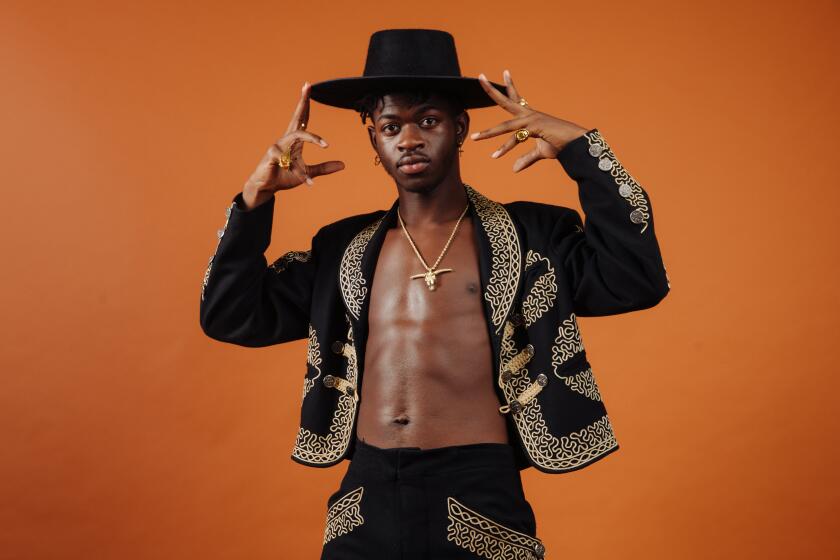‘Swing Time!’ Ensembles Hit Right Notes
- Share via
VARIOUS ARTISTS
“Swing Time! The Fabulous
Big Band Era 1925-1955”
Columbia
* * * * *
As long as a single musician has the talent to put pen to paper, craft an arrangement and find, say, 15 musicians to interpret it, there will be a big-band presence in jazz. The cutoff point assigned to this album simply means that by 1955 such factors as the expense of air transport reduced drastically the economic viability of retaining an orchestra on a year-round basis.
The 66 cuts in this three-CD set offer an almost complete cross-section of the great ensembles that marked the essential big-band years. (The only significant omission is the Andy Kirk Orchestra, a key unit in the 1930s.)
What does one learn from the three hours of music in this handsomely produced and well-annotated package? There are reminders of the vital role played by Fletcher Henderson, whose 1925 “Sugar Foot Stomp” preceded the swing era by a decade; and of the unjustly forgotten Don Redman, represented not only by his own band but also as arranger for this Henderson track and for one by the Chocolate Dandies.
The album is packed with underrated masterpieces: Artie Shaw’s strange, ominous “Nightmare,” best of all the big-band radio themes; Red Norvo’s classic version of “Remember”; a “Sweet Lorraine” by Teddy Wilson’s short-lived but admirable big band; Claude Thornhill’s orchestra playing the Gil Evans arrangement of Rimsky Korsakov’s “Arab Dance,” and Jack Jenney’s “Star Dust,” arguably the most memorable trombone solo on record.
The swing bands, providing dance music at a time when jazz concerts were nonexistent, came up with such trivia as Jimmy Dorsey’s “Green Eyes,” Tommy Dorsey’s “Marie” (saved by Bunny Berigan’s masterful trumpet solo) and of course Glenn Miller’s “In the Mood,” the most overhyped instrumental of them all.
Each band is assigned a single track with a few exceptions: Duke Ellington appears four times, deservedly, as does Benny Goodman; Harry James has three cuts. The obscure Eddie Stone has one, which is one too many. (Why use his “Caravan” rather than Ellington’s own?) Equally expendable is the Casa Loma orchestra’s “Under a Blanket of Blue,” one of those pseudo-dreamy ballads sung by the band’s resident crooner, Kenny Sargent.
The chronological sequence enables one to follow the slow and inevitable evolution of big-band music in terms of both writing, execution and the successful incorporation of arranged and improvised passages. The earliest pieces--”Sweet Georgia Brown” by the all-white California Ramblers, and the Henderson number--indicate that this symbiosis was well under way: Red Nichols and the Dorsey Brothers are featured on the first track, and Henderson’s key soloist was no less a virtuoso than Louis Armstrong.
Over the years the ensembles grew larger, enabling the writers to expand the range of tone colors: As early as 1932, Don Redman’s band sported three trombones, a rarity then, brilliantly used in his version of “I Got Rhythm.” Duke Ellington was the supreme master of the ensemble-and-soloist incorporations, as we hear colorfully illustrated in an instrumental version of “Don’t Get Around Much Any More.”
The growth of the big band reached an extreme with some of Stan Kenton’s more grandiose efforts, though the brass-heavy band chosen to represent him here (a 10-man brass section slugging its way through “The Peanut Vendor” with five percussionists) reminds us that every once in a while the band did succeed in swinging.
Some of the more inventive bands fell by the wayside because of commercial failure (Jack Teagarden struggled for eight years before giving up), others because of the drinking problems of the leader (Bunny Berigan) or the sidemen (Ray Noble’s American orchestra). Some were simply territory bands (Don Albert) or were led by men who lacked the talent to be leaders (Teddy Hill, in whose band Dizzy Gillespie made his first recordings).
Occasionally vocal and instrumental values came together successfully, as in Frank Sinatra’s “All or Nothing at All” with Harry James, the teaming of Roy Eldridge’s horn with Anita O’Day’s vocal for “Let Me Off Uptown,” and Trummy Young singing “Tain’t What You Do” with the Jimmie Lunceford band. The bandleaders, constantly under pressure to reconcile the requirements of dancers and the demands of serious aficionados, succeeded in cases like these.
Packed with surprises (an unreleased Charlie Barnet cut, a Pee Wee Russell clarinet solo in Louis Prima’s band), “Swing Time” is a valuable boxed set that belongs in the library of any self-respecting jazz collector.
Which were the 10 most important bands? Balancing the duration of their impact and the musical value of their contribution, these would be my choices, in order of importance: Duke Ellington, Count Basie, Jimmie Lunceford, Charlie Barnet, Artie Shaw, Benny Goodman, Fletcher Henderson, Woody Herman, Don Redman, Stan Kenton. (The odds against any reader’s total agreement with this list are 1,521,197 to 1.)
More to Read
The biggest entertainment stories
Get our big stories about Hollywood, film, television, music, arts, culture and more right in your inbox as soon as they publish.
You may occasionally receive promotional content from the Los Angeles Times.









